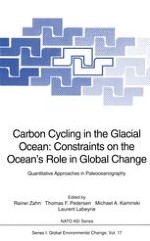A comprehensive progress report on the multi-disciplinary field of ocean and climate change research is given. It compiles introductory background papers and leading scientific results on the ocean-atmosphere carbon cycle with emphasis on the ocean's carbon inventory and the various components involved. The relationship between plankton productivity, carbon fixation, oceanic PCO2 and climate change is investigated from the viewpoint of long-term climatic change during the late Quaternary cycles of ice ages and warm ages. The various approaches range from micropaleontology over organic and trace element geochemistry to molecular isotope geochemistry.
